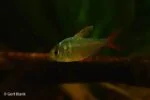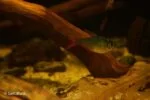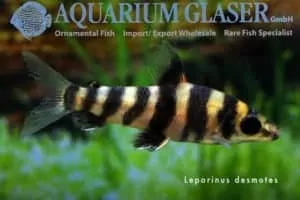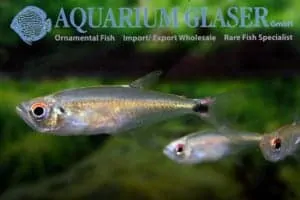Hyphessobrycon columbianus
Hyphessobrycon columbianus was officially described in 2002 by Zarske and Géry. The genus name Hyphessobrycon can be broken down into two ancient Greek words. Hyphesson means “a little smaller” and “bryko” means biter. Together they form the genus name “small biter”. The species name columbianus is a reference to their country of origin Colombia.
Description
The body of Hyphessobrycon columbianus is relatively high and somewhat flattened laterally. The flank has a slight bluish tint. The fins are coloured red except for the pectoral fins. The females can reach a maximum total length of about 7 centimetres.
This species is very similar to Hyphessobrycon ecuadorensis and was also marketed under this name until it was officially described. The Hyphessobrycon panamensis is also very similar to the Hyphessobrycon columbianus.
The difference between the males and females can be seen in adult animals after study. With young animals, it becomes a lot more difficult. Sexually active males are more intensely colored than females. The males are also slightly smaller and slimmer in build. The dorsal fin, on the other hand, is somewhat longer in males.
Hyphessobrycon columbianus is a peaceful schooling fish. They can be easily combined in a community aquarium. Keep them in a school of at least 8! You can easily combine them with other members of the Characidae family, as long as they are about the same size. They usually just leave smaller fish species alone.
Biotope
The habitat of the Hyphessobrycon columbianus is located in the north of Colombia, near the border of Panama. They inhabit the river basin of the Rio Acandi.
Diet
In the wild, Hyphessobrycon columbianus is an omnivore. They prefer small worms, insects and other swimming animals. Plant material and detritus are also eaten, albeit in smaller quantities.
In the aquarium, it is not a picky eater. To keep them healthy and well-colored it is necessary to feed them varied. Various live or frozen food such as Artemia, mosquito larvae, daphnia, and tubifex should not be missed. You can alternate this live or frozen food with flake food or small granulate. Make sure that this dry food also contains some vegetable material or mix it with some spirulina flakes.
The Aquarium
Because Hyphessobrycon columbianus is a fairly active fish and must be kept in a school, a relatively large aquarium of at least 90 to 100 centimetres wide is preferred. Few requirements are imposed on the decoration of the aquarium. Make sure there are some elements that break the lines of sight, such as higher growing plants. A little bit of current is also appreciated.
The temperature of the water may be between 20 and 28 degrees Celsius, the pH between 5.0 and 7.5 and the hardness between 1 and 10 GH. As with all fish, the lifespan of the fish will be shortened as they are kept towards the minimum or maximum temperatures.
Spawning Tank and Conditioning
Hyphessobrycon columbianus regularly lay eggs in a well-established community aquarium. With a bit of luck, even a single young will survive and grow into a beautiful adult. To achieve better results, it is better to set up a special breeding aquarium.
Use an aquarium of about 40 to 50 centimetres wide as a breeding aquarium. Because the parents eat the eggs, some form of protection is needed for the eggs. Therefore, place a mesh on the bottom that is fine enough to keep the parents off the bottom but coarse enough to allow falling eggs through. Alternatively, you can also use a piece of plastic grass or a layer of marbles. The eggs can then fall between the “grass blades” and are then virtually inaccessible to the parents. A second alternative method is to fill the breeding aquarium with large tufts of Java moss.
The aquarium should also be equipped with a small heater and a sponge filter. A sponge filter is preferred because these filters do not cause too much current and cannot suck up the young Hyphessobrycon columbianus.
Lighting in the breeding aquarium is not necessary and it is even better not to use lighting for spawning. The water may be mildly acidic to neutral with a pH of 6.0 to 7.0.
You can use a breeding group of one or two males with multiple females or a male and female alone. Preferably feed the parents with live or frozen food to keep them in good shape. You could also add the female or females first without the males. This way they get to make a lot of eggs before they spawn.
The Spawn
After adding the male, the fish will lay their eggs. Spawning usually takes place early in the morning. The eggs are scattered around during spawning and fall to the bottom. The spawn continues for about two to four hours. A single adult female can lay up to 2,000 eggs.
Raising the fry
Hyphessobrycon columbianus eggs hatch after about 24 to 36 hours, depending on the temperature. The young fish are very small and initially lie on the bottom. They then feed on their egg yolk sac for a while. As soon as they can swim freely, you can feed them with infusoria and/or Liquifry. As soon as they have grown a bit, you can switch to freshly hatched Artemia. The young fish will grow fairly quickly on these foods.
Video
Author
John de Lange
Copyright images
Gert Blank
F. Ingemann Hansen – Akvariefotografen.com

























Reviews
There are no reviews yet.